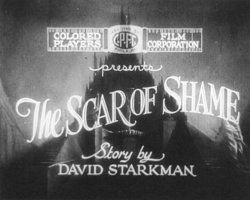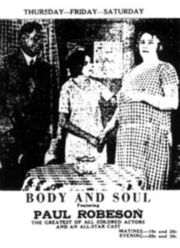 Poster for Micheaux's film
The Exile (1931)
Poster for Micheaux's film
The Exile (1931)
The race movie or race film was a cinematic genre which existed in the United States between about 1915 and 1945. It consisted of films produced for an all-black audience, featuring black casts.
In all, approximately five hundred race films were produced. Of these, fewer than one hundred remain. Because race films were produced outside of the Hollywood studio system, they have been largely forgotten by mainstream film historians. Nevertheless, in their day, race films were very popular among African American theatergoers, and their influence continues to be felt in cinema and television marketed to African Americans.
In addition, race films were some of the first financially successful independent films.
Contents |
Financing and production
Much like early black sitcoms, race movies were most often financed by white-owned companies and scripted by white writers. However, black-owned studios existed, the most notable of which was the Micheaux Film Corporation, founded in 1918 in Chicago by Oscar Micheaux. On his posters, Micheaux advertised the fact that his films were produced and scripted exclusively by blacks.
Venues
 Title card of
The Scar of Shame (1927),
the archetypal race movie.
Title card of
The Scar of Shame (1927),
the archetypal race movie.
In the south, to comply with segregation, race movies were screened at designated black theaters. Though northern cities were nominally unsegregated, the situation was virtually the same in practice, with race films being confined to theaters in black neighborhoods.
While it was extraordinarily rare for race films to be shown to white audiences, white theaters often reserved special time-slots for black moviegoers. This resulted in race films often being screened as matinees and midnight shows. During the height of their popularity, race films were shown in as many as 1100 theaters around the country.
Many large northern theaters incorporated special balconies reserved for blacks. This practice gave rise to the term "peanut gallery", which was originally a racist epithet used by disdainful white theater patrons.
Themes
Though produced primarily in northern cities, the target audience of these films consisted primarily of poor southern blacks and southerners who had migrated northward. Consequently, many race films, particularly those produced by white studios, attempted to impart middle-class urban values, especially education and industriousness. Common themes included the "improvement" of the black race, the supposed tension between educated and uneducated blacks, and the tragic consequences in store for blacks who resisted bourgeois values. The most famous race movie, The Scar of Shame, incorporates all of these themes.
Race films typically avoided explicit depictions of poverty, ghettos, social decay, and crime. When such elements appeared, they often did so in the background or as plot devices. Perhaps most strikingly, race films rarely if ever treated the subjects of social injustice and race relations.
Not surprisingly, race films avoided many of the popular black stock characters found in contemporary mainstream films, or else relegated these stereotypes to supporting roles and villains. Micheaux in particular went to great lengths to depict his protagonists as educated, prosperous, and genteel. Micheaux hoped to give his audience something to help them "further the race", though in doing so, he often sacrificed plausibility. It is interesting to note that many modern black sitcoms, such as The Cosby Show, have followed a similar pattern, and have encountered similar criticism.
Historical significance
 Body and Soul (1924), Paul Robeson's film debut
Body and Soul (1924), Paul Robeson's film debut
Race movies are of great interest to students of African American cinema not only for their historical significance, but also because they showcase the talents of actors who were relegated to demeaning, stereotypical supporting roles in mainstream studio films. Hattie McDaniel and Clarence Muse are two of the most striking examples. A few stars from race films were able to cross over to relative stardom in mainstream films – for example, Paul Robeson and Evelyn Preer. Indeed, Hollywood studios often used race movies as a ready source of black talent.
Notable race movies
The Birth of a Race (1915), a documentary made in response to The Birth of a Nation
The Homesteader (1919), Micheaux's first film
Within Our Gates (1919)
Body and Soul (1924), Paul Robeson's cinematic debut
The Scar of Shame (1927), the most well-known example of the genre
The Exile (1931)
Lying Lips (1939)
Print references
- Diawara, Manthia. Black American Cinema. Routledge, 1993. ISBN 0415903971
- Gaines, Jane M. Fire and Desire: Mixed-Race Movies in the Silent Era. University Of Chicago Press, 2001. ISBN 0226278751
External links
Categories: Film genres




 216.73.216.190
216.73.216.190 User Stats:
User Stats:
 Today: 0
Today: 0 Yesterday: 0
Yesterday: 0 This Month: 0
This Month: 0 This Year: 0
This Year: 0 Total Users: 117
Total Users: 117 New Members:
New Members:
 216.73.xxx.xxx
216.73.xxx.xxx
 Server Time:
Server Time: